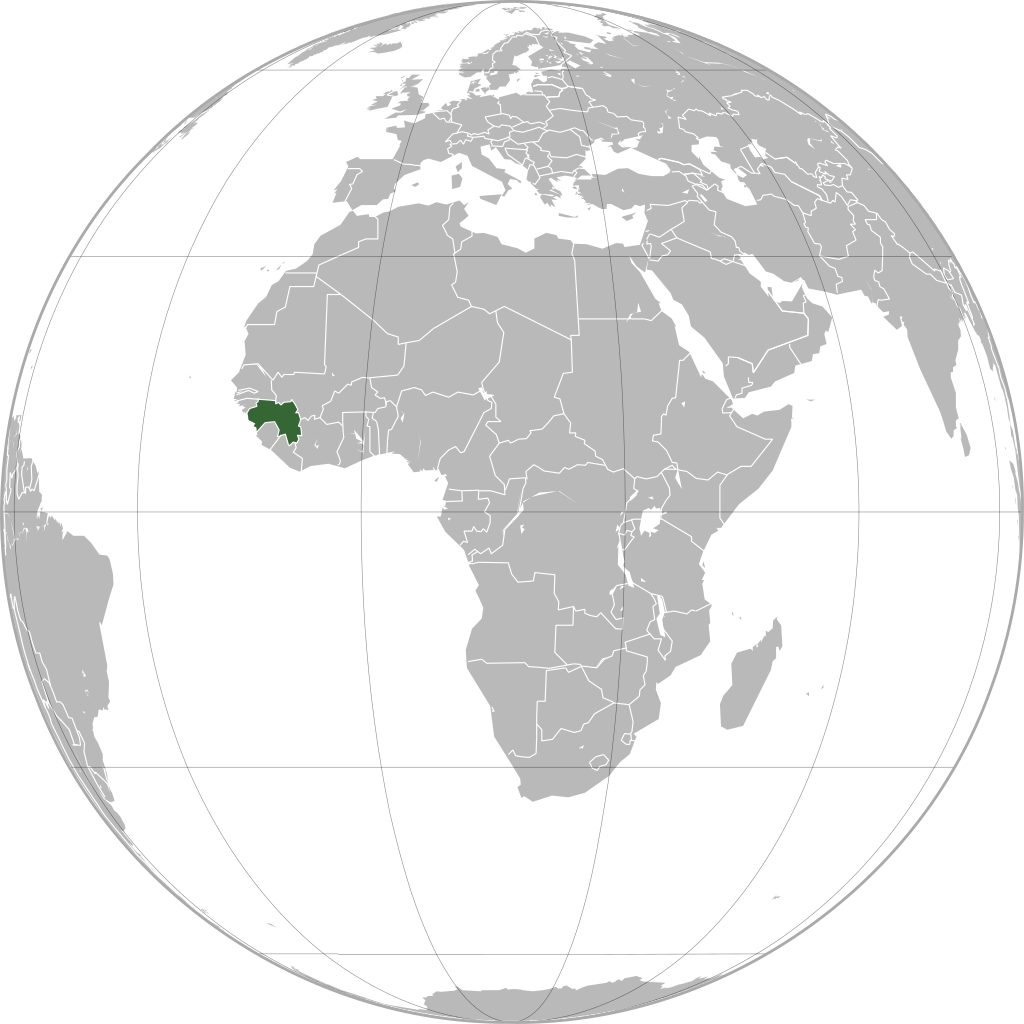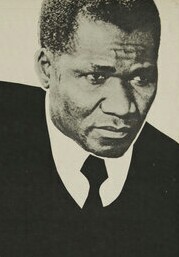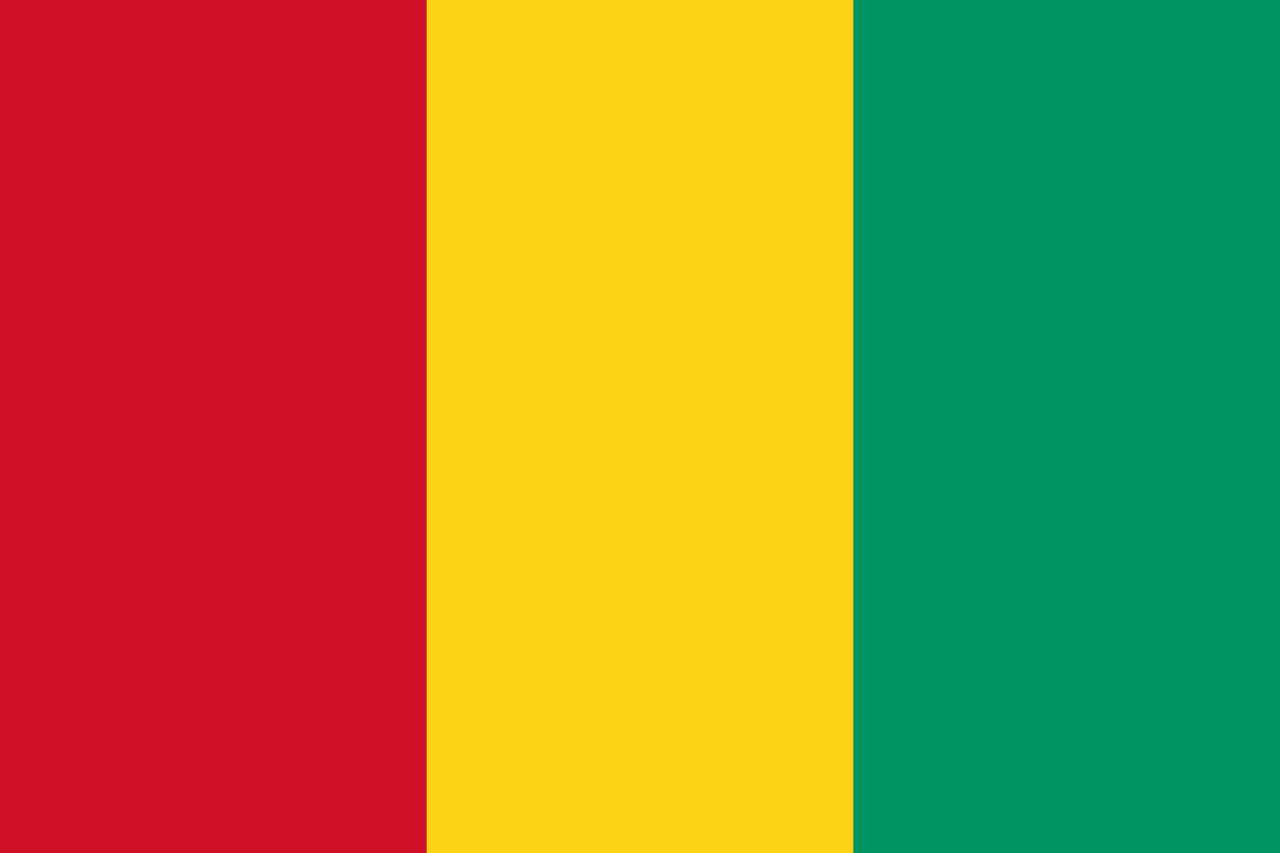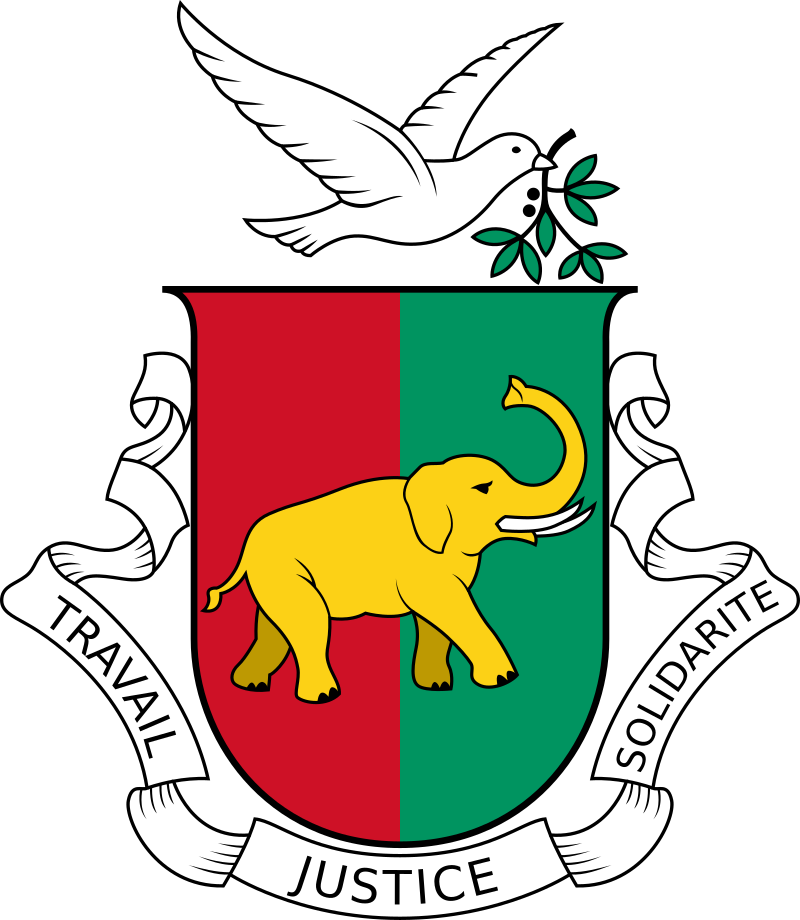More languages
More actions
| Republic of Guinea (1958-1979) People's Revolutionary Republic of Guinea (1979-1984) | |||||||||
|---|---|---|---|---|---|---|---|---|---|
| 1958–1984 | |||||||||
Motto: Work, Justice, Solidarity | |||||||||
Anthem: Freedom | |||||||||
 | |||||||||
| Capital and largest city | Conakry | ||||||||
| Official languages | French | ||||||||
| Dominant mode of production | Socialism | ||||||||
| Government | Unitary semi-presidential party-state | ||||||||
• President and Secretary General of the PDG-RDA | Sékou Touré | ||||||||
• Prime Minister | Louis Lansana Beavogui | ||||||||
| Legislature | National Assembly | ||||||||
| History | |||||||||
• Established | 1958 | ||||||||
• Dissolution | 1984 | ||||||||
| Population | |||||||||
• 1985 estimate | 5,470,716 | ||||||||
| Currency | 1959 -1971: Guinean Franc 1971-1985: Guinean Syli | ||||||||
| |||||||||
The People's Revolutionary Republic of Guinea, commonly known as Guinea, was a socialist state in West Africa from 1958 to 1984 established by the Democratic Party of Guinea following the rejection of the French Community during the 1958 constitutional referendum and the drafting of a constitution on November 12th that same year.
Since independence, Guinea was subjected to numerous destabilization campaigns from western powers, among which were operations Persil and Green Sea. Despite this, the Democratic Party was able to maintain power and continued to send aid to liberation movements across Africa. After the passing of Ahmed Sékou Touré, Interim President Louis Beavogui was overthrown by military forces in 1984, resulting in the restoration of capitalism.
History
1958 constitutional referendum
See also: 1958 French constitutional referendum
After the successful unionization efforts among Sekou Touré and the Democratic Party, such as the creation of the Federation of Workers' Union of Guinea and the execution of labor strikes in coordination with other labor movements in French West Africa, the base of the Democratic Party of Guinea began pushing for independence in the midst of the 1958 constitutional referendum. Sekou Touré, who was then Vice President of the autonomous loi cadre government, didn't endorse independence initially leading to many to suspect he had been corrupted by the interterritorial leadership of the African Democratic Rally. Touré's endorsement of independence came after his meeting with the interterritorial leadership during the PDG's party congress, after which he was confronted by crowds of Guineans shouting their opposition to the French Community. Despite this, Touré continued to express his intent to work out a similar agreement of cooperation and stated that independence was a means of Africans expressing their maturity on the world stage and a necessary footpath to engage with Europe as equals. The French government however was disinterested in this cooperation, and in response to the Democratic Party's endorsement of independence prior to the referendum colonial administrators planned the complete isolation of a post-independence Guinea. Colonial officials cut telephone wires, removed machinery from the capital port, stopped moving goods through Guinean ports, hid infrastructure plans and burned medicine en masse. Most notably, the 4 billion Francs in the Guinean reserve were relocated to Dakar by military personnel and French technical staff were instructed to destroy what they can't bring back to France.[1]
Independence
After rejecting the French Community, the territorial assembly declared the formal independence of the Republic of Guinea and empowered itself with the drafting of a new constitution. As a result, post-independence Guinea saw its self completely isolated and after France most Guinean imports, the country was stripped of its major export revenues and saw its economic progression severely limited;[1] however, the creation of the Ghana-Guinea Union in an attempt to build a United States of Africa granted the nation substantial financial support from the Republic of Ghana.[2] A mere 17 days after securing independence, Sekou Touré and the Democratic Party broke off from the African Democratic Rally and formed the African Democratic Revolution. The new government also proclaimed a National Democracy, the stage in which colonial-era structures are replaced under the one-party state for the purpose of suppressing ethnic and social contradictions to develop a nation. Unlike a People's Republic, National Democracy doesn't presuppose class struggle and instead focuses on mass organization.[3][4][5]
With the start of China's 1960 aid program to Africa, Guinea was gifted an interest free loan equivalent to 25 million US dollars during Touré's state visit to Peking. Though Chinese aid grew less substantial over the years, the PRC continued to be an important source of development help.[6]
In November 1961, teachers in Guinea took part in demonstrations in protest of working conditions, however documents presented by students protesting in support of the teachers promoted Guinea joining the Eastern Bloc and criticized its neutrality in the Cold War. The Guinean government believed the Soviet embassy was in collusion with the strike in an attempt to push Guinea into the Eastern bloc, prompting them to label the affair as the Teacher's Plot and expel Soviet ambassador Daniel Solod after the suppression of the strikes.[7][8]
Operation Green Sea
See also: Portuguese Colonial War, Operation Green Sea
Under the leadership of the Democratic Party, Guinea played an active role in the national liberation of Guinea-Bissau by housing and supplying the African Party for the Independence of Guinea and Cape Verde (PAIGC). Amilcar Cabral and his staff were headquartered in the Conakry, where they organized and strategized their revolution away from front-lines.[9] This safety was nearly compromised during Operation Green Sea, in which Portuguese forces Guinean National Liberation Front (FLNG) elements launched an amphibious invasion of Conakry[10] in an attempt to assassinate Cabral and Nkrumah, as well as depose Touré's government and install exiled opposition leader Siridiou Diallo who was living in exile in Paris.[11] During the invasion, the PAIGC headquarters in Conakry was destroyed, Portuguese POWs were released[12] and Nkrumah's villa was bombed; however the Portuguese Army was repelled before they could complete their major objectives.[13] Despite the retreat of Portuguese forces, fighting between FLNG and Guinean government forces ensued, eventually resulting in the defeat of the FLNG and the arrest and torture of those captured.[14] Guinean support for PAIGC activities in the country continued until the end of the Portuguese Colonial War in the event of the Carnation Revolution.[15][16]
Cultural Revolution and the Party-State
Government
Concept of the party state
As formulated by Ahmed Sekou Touré, the Party State is the merging of the administrative functions of society with the vanguard party; thus entrenching the revolution in all aspects of public policy and solidifying a monopoly of political power within the vanguard.
Local Revolutionary Authorities
The basic committee is the Local Revolutionary Authority (PRL), whose executive is composed of the Mayor, the Deputy Mayor, the four directors of the local authorities and the chairwoman of the Special Women’s Committee. The Mayor is the chair of the PRL executive and is tasked with the organization and supervision of the the activities of local authorities. The general duties of the Mayor is the maintenance of economic and legal discipline, presenting and managing the PRL budget, and safeguarding the PDG's monopoly of political power. Among their duties of signing marriage and death certificates, they are also police officers and preside at sessions of the People's Court. In the event of the mayor's absence, the Deputy Mayor takes his/her place and assumes authority over his/her duties.[17]
The PRL executive is divided up into the authorities of administration, economy, public works and communications, and social affairs. The local administrative authorities were in charge of managing the flow of information and the press, carrying out the local census, maintaining and managing local archives, organizing PDG and PRL meetings, as well as keeping track of records ranging from births, deaths, marriages and judicial proceedings. The local economic authorities managed the production, marketing and fair distribution of all goods and services. Local authorities for public works and communications were tasked with the development and regulation of all postal services and telecommunications. Last are the local authorities for social affairs, which were responsible for the Revolutionary Education Centers (CER) of the PRL, literacy training, scientific experimentation, social assistance, funeral services, maintaining cemeteries, as well as organizing and supervising events surrounding sports, culture and art.[17]
Each PRL authority was chaired by a Chief Officer, who would be assisted by a technical work committee. Technical work committee members would be nominated by the chief officers of said authority and appointed by the Mayor. Technical work committees were then divided into numerous, specific, subcommittees.[17]
Ran under the association of the PRLs were the special youth and women's committees, which were tasked with organizing youth and empowering women in Guinean political society. Within each local garrison contained a Military Committee (CUM), which was the basic political organization corresponding to the PRLs. This was done as a means of tightening the grip of the PDG on the Guinean Army, thus completing Sekou Touré's Party State.[17]
Party sections
Comprising of several PRLs, the sectional level is the second stage of organization of the PDG, and generally corresponded to an arrondissement. Each section contained a youth and women's committee, both of which were subordinate to the Executive Committee while the arrondissement workers' committees. were subordinate to both the Executive Committee and the Regional Workers' Committee. The sectional congress was the decision-making body and the sectional conference would make decisions between congresses.[17]
Regional Revolutionary Authorities
The Revolutionary People's Republic of Guinea was divided into 33 administrative divisions and 34 party federations. A federation was composed of a group of party sections functioning within an administrative region, of which only Conakry would contain two federations. Federations were managed by a federal executive, the members of which were elected by the congress and selected from the Chief Officers of the sectional Executive Committees and members of the outgoing federal executive. This executive has four ex officio members: the governor of the administrative region, the chairwoman of the regional women's committee, and the general secretaries of the regional committee of the Youth of the African Democratic Revolution (JRDA) and the regional workers' committee. The chief officers of party federations were known as Federation Secretaries. The decision-making bodies of the federations were the Federal Congresses, Regional Councils for the Revolution and Regional Legislative Assemblies. The functions of the Regional Revolutionary Authorities (PRR) were exercised by the PDG Federal Executives and Regional Executive Councils. Regional women's, youth, and workers' committees were integrated into the regional administrations.[17]

National level
The Party National Congress elects the Supreme Leader of the Revolution, the General Secretary of the PDG and the members of the Central Committee. The National Political Bureau (BPN) is an executive body composed of seven members elected from the members of the Central Committee. By law, the General Secretary of the PDG is the President of Guinea. The Central Committee is the legislative arm of the Democratic Party of Guinea. The national decision-making bodies are the National Congress, the National Council of the Revolution (CNR) and the Legislative Assembly. Executive power is exercised by the President of the Republic, who is the Head of State, the Central Committee (CC) and the Government. The latter is divided into seven Domains, each of which is headed by a member of the National Political Bureau. Three kinds of integrated organizations operate at national level: the national committees of the JRDA, the national women’s committees and the national workers’ committees.[17]
Administrative divisions
Economy
Labor Unions
Under the leadership of Democratic Party PRLs, all Guinean enterprises had a production committee (CUP), a union section or a management committee depending on the number of laborers. Workers belonged to co-operatives covering several groups of laborers. Administrative affairs of these organizations were decided by weekly general meetings. The CUPs, Union Sections and Management boards of the co-operatives maintained complete political control over businesses, authorities, companies and agencies to ensure that they were properly managed by the interests of the Democratic Party. The labor unions and production boards drew production plans to keep track of executed tasks. They were also responsible for the training and political education of workers in their units.[17]
Infrastructure
Demographics
References
- ↑ 1.0 1.1 Elizabeth Schmidt (2007). Cold War and decolonization in Guinea, 1946-1958. Ohio University Press.
- ↑ Ahmed Sékou Touré @ 100
- ↑ Sekou Toure. Doctrine and Methods of the Democratic Party.
- ↑ Sekou Toure. Africa on the Move.
- ↑ Sekou Toure. Strategy and Tactics of the Revolution.
- ↑ “In 1960 the People’s Republic of China began their aid program to Africa with an interest-free loan equivalent to US $25 million given to President Toure while he was on a state visit to Peking. Curtailed some¬ what in the mid 1960s PRC aid has continued to be an important source of development help. By 1970 China was Guinea’s third largest source of imports. Guinea depends heavily on Chinese rice to meet continued food shortages.”
Thomas O'Toole (1978). Historical dictionary of Guinea (Republic of Guinea/Conakry). Scarecrow Press. - ↑ “TEACHER'S PLOT. An alleged plot against the government announced by Guinean leaders in November 1961. Basically teachers were complaining about working conditions but some of the documents presented by the pupils demonstrating in support of the teachers contained some leftwing ideological criticisms of the government. Among these statements were those suggesting that Guinea had to choose between Eastern- bloc and Western-bloc support Toure ordered the expulsion of the Soviet ambassador suggesting that the ambassador was supporting teachers' demands that the Guinean government become a member of the Eastern bloc. The Soviet role in the strike has never been verified but five members of the teachers' union were executed and others fled or were imprisoned. See PLOTS”
Thomas O'Toole (1978). Historical dictionary of Guinea (Republic of Guinea/Conakry). Scarecrow Press. - ↑ “"Teacher’s Plot" put down; Daniel Solod, Soviet Ambassador, expelled”
Thomas O'Toole (1978). Historical dictionary of Guinea (Republic of Guinea/Conakry). Scarecrow Press. - ↑ “Conakry, the capital of Guinea, served as the headquarters of the PAIGC throughout their national liberation struggle and Touré and the PDG provided military, political, and educational support to the PAIGC throughout their struggle for independence. In the liberated zone of Conakry, Cabral and the PAIGC were able to train PAIGC cadre, mobilizers, military personnel, and youth. They were able to forge strong diplomatic ties with revolutionary states like the USSR, China, and Cuba with which the PAIGC was able to secure aid in the form of weapons, military training, and technical advisors.”
Nnamdi Sekou (2023-04-20). "The Relationship Between Sekou Touré and Amilcar Cabral" Hood Communist. - ↑ “On the night of 21–22 November 1970 about 200 armed Guineans — attired in uniforms similar to those of the Guinean Army and commanded by Portuguese officers — and 220 African-Portuguese and Portuguese soldiers landed at points around Conakry. The soldiers landed from four unmarked ships, including an LST and a cargo vessel, and destroyed 4 or 5 supply vessels of the PAIGC. Others landed near President Touré’s house, which they burnt. [4] Touré was in an unknown location at the time, where he announced that “foreign warships” were in Guinean territorial waters, the President declared in the afternoon that “hundreds and hundreds” of “mercenaries of various nationalities” were in the Guinean capital”
"50th Anniversary 22 November 1970 “Operação Mar Verde”" (2020-11-26). All-African People's Revolutionary Party. - ↑ “Thad many targets that included the Guinean radio station, and TV; to kill Sekou Touré, Kwame Nkrumah, Amilcar Cabral and other PAIGC leaders; kill the President of the Guinea National Assembly, Saifoulaye Diallo, the Prime Minister Lassana Beaguvi, among others.
The imperialist invader had on board, anti-Guinean Siridiou Diallo, an exile living in Paris, who would be installed as “president” of what was to become neo-colonial Guinea-Conakry after Sekou Touré was neutralized (if their plan had worked).”
"50th Anniversary 22 November 1970 “Operação Mar Verde”" (2020-11-26). All-African People's Revolutionary Party. - ↑ “Other soldiers captured two army posts, took control of the city’s main power plant, captured the headquarters of the PAIGC (but not Amílcar Cabral), and freed 26 Portuguese POWs who were being held by the PAIGC at Camp Boiro.”
"50th Anniversary 22 November 1970 “Operação Mar Verde”" (2020-11-26). All-African People's Revolutionary Party. - ↑ “When the raiders discovered that the Migs were not at the airport, they retreated after suffering casualties. 328 citizens of Guinea-Conakry died defending African soil. [...] This operation was considered a failure because the desired coup d’état was not achieved: the absence of the Mig’s at the airport made Commander Alpoim Calvão order the troops to return, fearing an attack by these planes for which they were not prepared, without support the FLNG fighters. Ironically later it was learned that his pilots were not yet ready for combat.”
"50th Anniversary 22 November 1970 “Operação Mar Verde”" (2020-11-26). All-African People's Revolutionary Party. - ↑ “The FLNG guerrillas who, despite the lack of support, still wanted to move forward with their mission were unable to overthrow the regime, due to the lack of support from the population they naively counted on and to the counterattack by the loyal forces against Sékou Touré supported by a contingent of Cuban troops. The fighting lasted several days, with the FLNG suffering numerous deaths and 100 of its members were taken prisoner, tortured and subsequently executed as well as a group of twenty men who deserted during the operation and who still went to the radio station to transmit that they supported the PAIGC and who wanted to belong to their ranks.”
50th Anniversary 22 November 1970 “Operação Mar Verde” (2020-11-26). All-African People's Revolutionary Party. - ↑ 50th Anniversary 22 November 1970 “Operação Mar Verde”
- ↑ The Relationship Between Sekou Touré and Amilcar Cabral
- ↑ 17.0 17.1 17.2 17.3 17.4 17.5 17.6 17.7 Cultural policy in the Revolutionary People's Republic of Guinea


